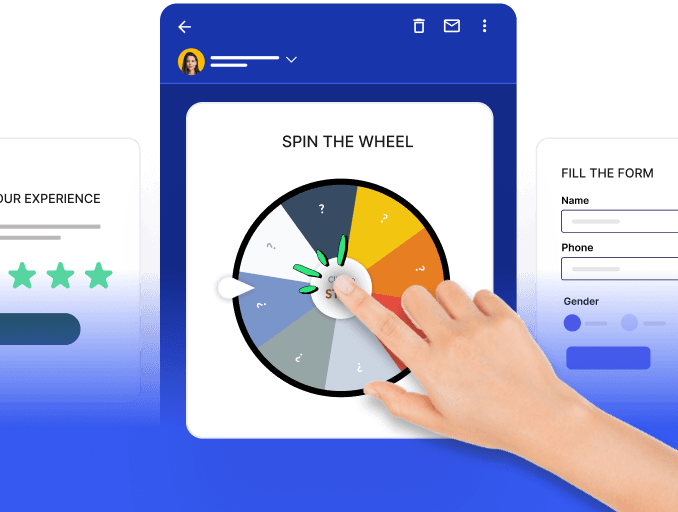Artificial intelligence has made remarkable progress in natural language processing, developing advanced conversational AI models like ChatGPT. ChatGPT is a valuable tool with many applications like copywriting, translations, etc. Quite often, ChatGPT can produce nonsensical responses. Accurate ChatGPT prompts are required to ensure the quality and efficiency of the output produced by the AI model.
Read on to know everything you need to know about ChatGPT prompts. We also have valuable resources in the end.
Table of contents
What are ChatGPT prompts?
ChatGPT prompts are the input or commands we give to the AI model, ChatGPT, to guide its responses. By using well-designed and specific prompts, users can eliminate the non-usable and non-specific results and promote well-structured and specific response generation.
Why do we need ChatGPT prompts?
When considering content marketing, one key way that AI is used most effectively is with writer's block and setting the foundations of a piece of content. This, however, is entirely dependent on the quality of the prompts you give it.
-George Blandford, Owner and Sales Director, UK Linkology
Apart from that, here are 5 reasons why you should seriously consider GPT prompts.
1. Specify context and intent: It eliminates the possibility of the AI model misunderstanding the query by providing specific details and background information.
2. Control quality and style: Prompts also enable users to specify the quality and style of the content they want the AI model to produce. Content creators, for instance, can guide ChatGPT to write content in a professional or friendly tone, depending on their needs.
3. Generate structured content: Prompts help receive organized responses based on the user's requirements. A user can ask ChatGPT to return a response in the form of a table, bullets or even a custom template.
4. Better efficiency and user experience: Using prompts results in fewer errors in the context, style, structure, etc., of the content produced, reducing the overall time required to generate the final product.
5. Mitigating bias: Users can craft prompts to instruct ChatGPT to use unbiased and inclusive language or provide a balanced perspective on sensitive topics.
The above points advocate using engineered ChatGPT prompts over non-engineered ones, as engineered prompts are specifically designed to guide ChatGPT to generate the desired outputs. In contrast, non-engineered ones allow it to generate responses without pre-defined guidance.
This table spotlights the difference between a structured ChatGPT prompt and an unstructured query.
| Engineered ChatGPT prompts | Non-engineered ChatGPT prompts | |
|---|---|---|
| Input | Clear instructions provided as input | Query without specific instructions |
| Context | Defined context and desired outcome | Relies on ChatGPT’s interpretation of the query |
| Control | More control over the response produced | Response depends on the ChatGPT |
| Output structure | Predefined structure, bullet points, table, etc. | Defined by ChatGPT |
| Consistency | More consistent responses based on instructions | Responses may vary based on ChatGPT’s interpretation |
| Bias mitigation | Can guide ChatGPT to avoid biased responses | Responses may have biased data based on factors like training data |
| Efficiency | Streamlined interaction with ChatGPT | Many back-and-forths may be required |
How to write perfect ChatGPT prompts?
Many pre-made ChatGPT prompts are available on the internet, but if you are still looking for one that suits your needs, creating a custom one for yourself is relatively easy. Below is a list of points you should consider when designing a custom ChatGPT prompt.
1. Determine the specific information you want
You can guide ChatGPT to give you specific details on a topic by specifying your exact needs. You can even ask it to write codes, for instance, create an SQL query for you to fetch specific sets of data. Marketers can also define if there are some specific points they want to be included in the generated content in case of copywriting. This helps ChatGPT produce content that is useful to you and aligns with your needs.
For instance, the ChatGPT prompt below shows how you can specify that you only want to know about the pros and cons of email marketing from the pool of information on email marketing.

2. Understand the strengths and limitations of ChatGPT
While creating your prompt, you must understand what ChatGPT is good at and what it cannot do. This helps you to create prompts that leverage ChatGPT’s strengths and prevent you from setting unrealistic expectations.
For instance, ChatGPT is good at creating content at scale, but it may produce biased or inaccurate output and it only has access to information available on the internet up till September 2021.
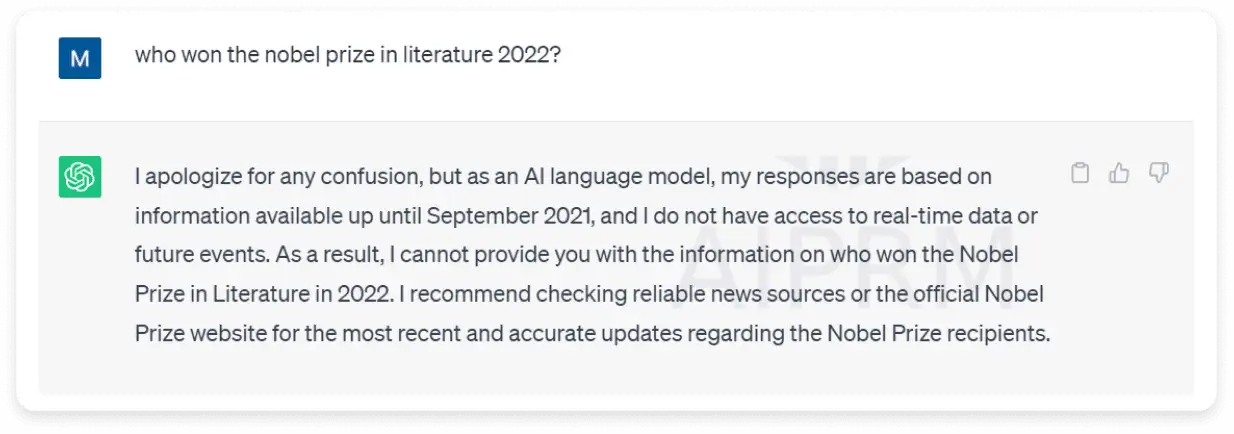
It is preferable for marketers to use ChatGPT for some tasks that can be done by leveraging its strengths, while some other tasks should be avoided, given its limitations. Take a look at some of the things that marketers can and can’t use ChatGPT for.
| Should use for | Shouldn't use for |
|---|---|
| Content creation | Strategic decision making |
| Personalization | Visual designing |
| Content ideation | Provide industry-specific expertise |
| Language translation | Real-time market monitoring |
| SEO optimization | Curate up-to-date information |
3. Provide context for who you’re writing for
Stating the context, topic, domain and target audience removes the chances of misunderstanding on the model’s behalf and guides it to produce content that is more relevant for and resonates better with your target audience.
The ChatGPT prompt below shows the user clarifying that he needs the product description for a product launch that is targeting specific professionals.
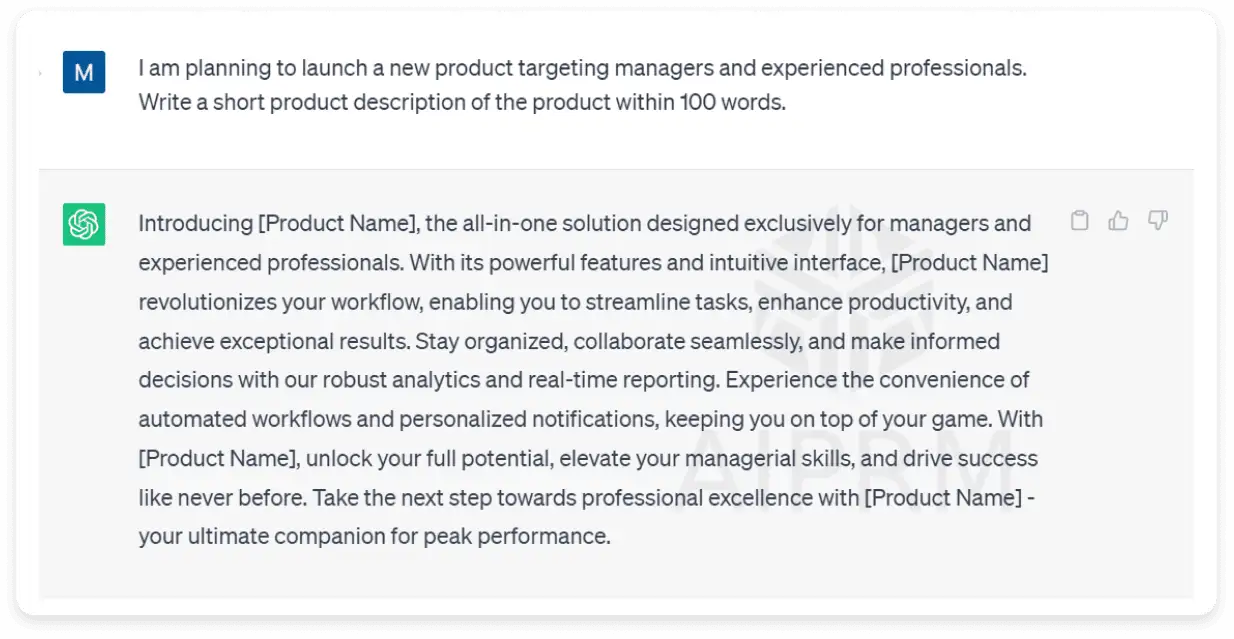
4. Convey the structure and format of output
You can have your responses presented in bullets, paragraphs, specific sections or as a table. You can do the same with the style and tone of the content to be produced by keeping the tone of the response professional, friendly and so on.
The ChatGPT prompt below shows how to request information in a specific format.
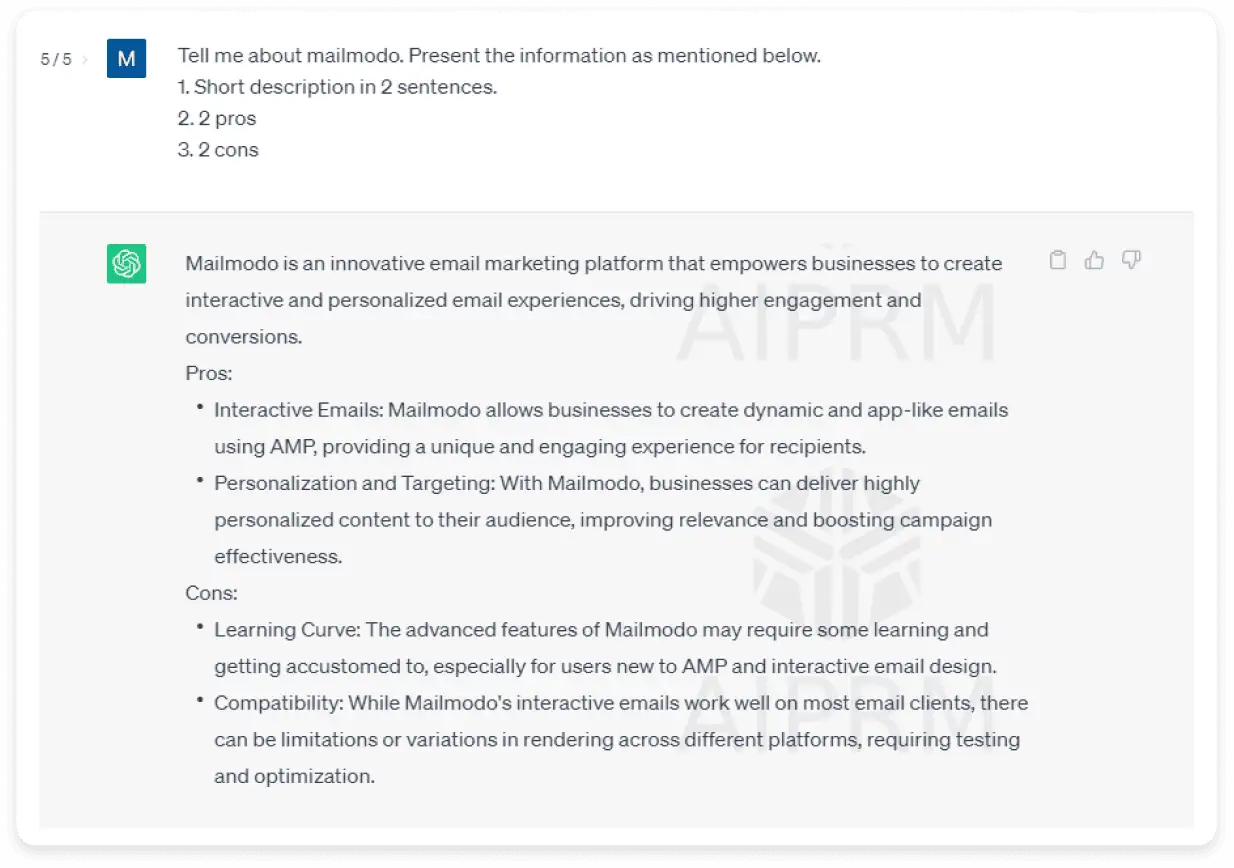
An extension of this would be to provide examples of the output you want to ChatGPT if you feel your prompt is very complex and an example would clarify your request. The image below shows how you can provide an example to ChatGPT so it understands better what it has to do.
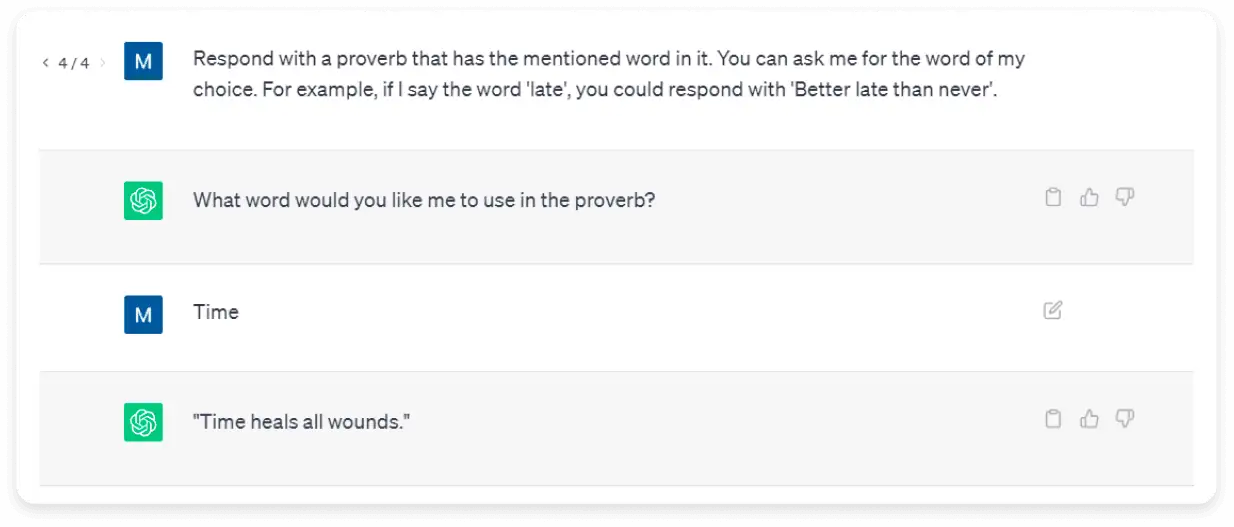
5. Use the right parameters
Parameters refer to the variables that define ChatGPT’s behavior and the kind of response it generates. They help you to generate responses that follow certain rules set by you. Using parameters, you can adjust the generated response's tone, style, length, etc.. This helps you to tailor the response to your needs more precisely.
You can check out more on how to use parameters in our guide on prompt engineering for marketers.
We can write this ourselves and spend time trying to get all of these parameters to play nicely, or we can prompt ChatGPT to provide ten examples that fit this criteria and see what it produces. If one of the results is suitable, we can make whatever adjustments are necessary, and we're done.
-Thomas Fuller, Digital Marketing Consultant
6. Test and improvise
Creating prompts can be an elaborate process and may require you to test different variations to determine which works best for you. You can experiment with different contexts, wordings and instructions to optimize the response. This will help you refine your prompt and choose the most accurate one that generates your desired responses.
It also has a regenerate response feature that allows you to ask ChatGPT to process the prompt again and generate a new response. You can use the feature if your prompt is fine and you just need another iteration of the output generated.
Take this prompt, for example, which resulted in a very long description along with pros and cons that were not structured.
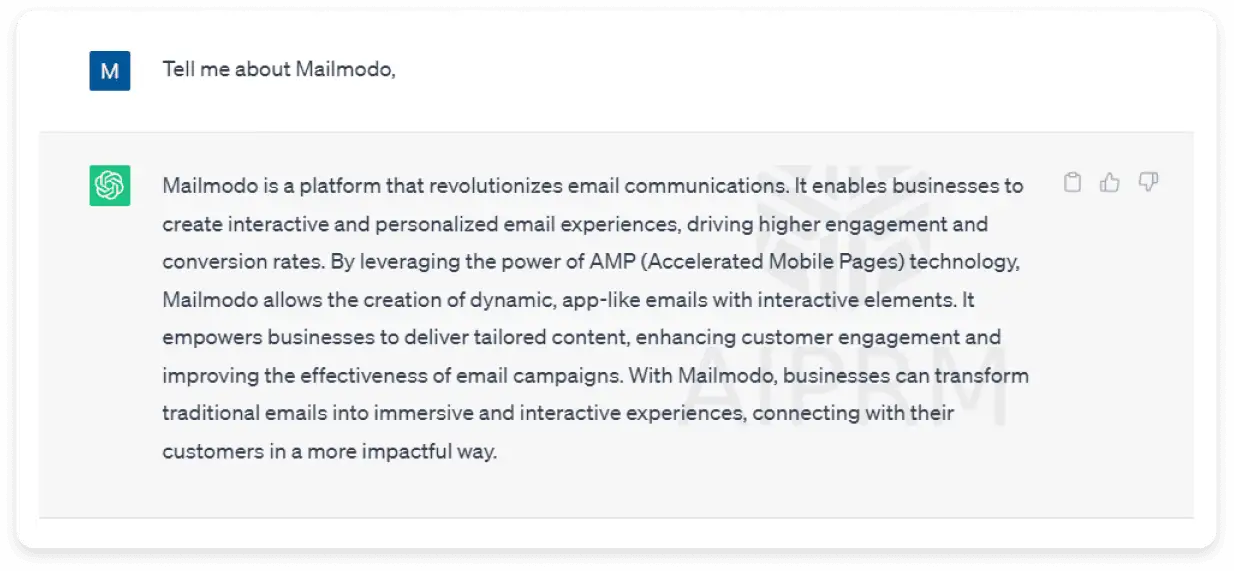
This was followed by another request to get the pros and cons too, along with the description.
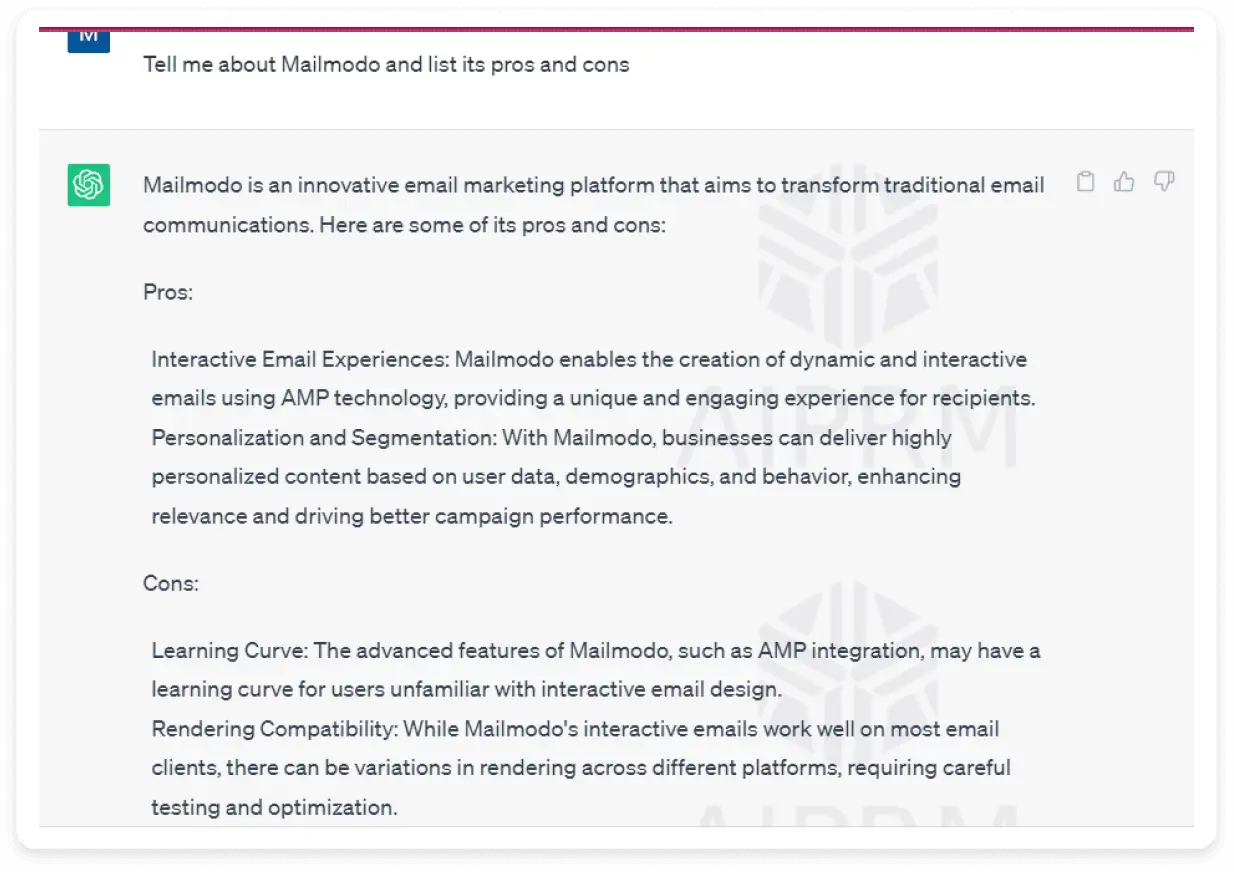
The final prompt was able to derive the desired result in a proper format.

You can also train ChatGPT for better results. This would include curating a quality dataset that reflects the target audience and desired outcome, fine-tuning the model on task-specific marketing data, staying updated on advancement in NLP and more. It would also expose it to different patterns, contexts and perspectives. Exposing the model to new data helps ChatGPT improve its performance over time.
7. Refer to prompt libraries
Prompt creation is a creative process and exploring the currently existing prompts can provide you with the necessary inspiration. You can explore prompt libraries and resources available on the internet for examples and insights. Following these existing prompts, you can improve the quality of your own prompts. You can refer to Mailmodo’s prompt library, which has over 200 prompts for various use cases.
Bonus tip: You must have seen the options in ChatGPT to clarify, exemplify, expand and so on, as seen in the image below. The table after the image explains how the options can help you.
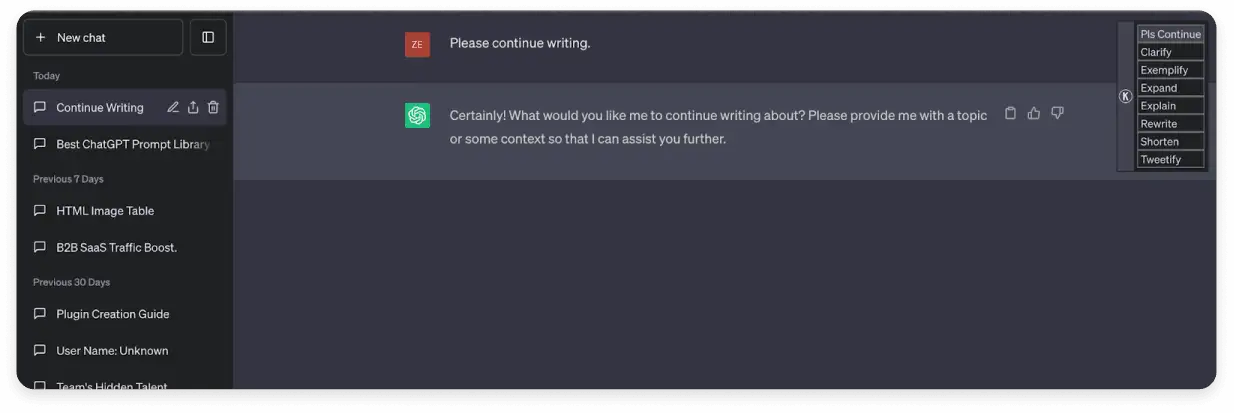
Here's a table defining the use of the given options in ChatGPT.
| Option | Use |
|---|---|
| Please continue | Request the model to continue generating text beyond its initial response or provide additional information. |
| Clarify | Ask the model for further explanation or clarification on a specific topic or concept. |
| Exemplify | Request the model to provide examples that illustrate or demonstrate a particular point or idea. |
| Expand | Ask the model to elaborate on a given topic, providing more details, examples, or additional information. |
| Explain | Instruct the model to provide a detailed explanation or breakdown of a concept, process, or phenomenon. |
| Rewrite | Request the model to rephrase or reword a given sentence or paragraph while retaining the original meaning. |
| Shorten | Ask the model to condense or make a given text shorter while preserving the key information or message. |
| Tweetify | Instruct the model to transform a given text into a format suitable for a tweet, typically limited in length. |
💡 Related guide: A Complete Guide to Prompt Engineering: Marketer's Edition
Marketing use cases of ChatGPT prompts
ChatGPT has proven to be a powerful tool for marketers for different aspects of their marketing endeavors. Below we talk about some specific use cases:
1. ChatGPT prompts for SEO
ChatGPT prompts can help in SEO strategies. Marketers can use ChatGPT to generate content ideas, identify relevant keywords and create meta descriptions. This helps improve website visibility, increase organic traffic and enhance overall SEO performance. Check out a few examples below.
Prompt for segmenting keywords: Imagine you are a digital marketer and trying to separate relevant and non-relevant keywords to promote (enter product) for English-speaking countries in Google ads search.
Prompt for researching trending topics: What are some trending topics I can write about for a blog on X? Can you group them into different topic clusters?
Check out some more in Mailmodo’s AI prompt library for SEO.
With AI, anyone can rapidly uncover and analyze key business metrics merely by posing questions. This has dramatically streamlined the process of identifying reasons for traffic dips or gauging the effectiveness of your SEO strategy.
-Edward Roberts, SEO Specialist, Page Not Found
2. ChatGPT prompts for ads
ChatGPT prompts can help advertisers generate engaging headlines and catchy ad copies. These prompts can also allow advertisers to generate copies for a specific audience following a specific tone or style. It can also help you in building your own advertising strategy. Check out a few examples below.
Prompt for creating an ad campaign: Create an advertising campaign about [company, product, or service] targeting [target audience]. Include key messages and slogans and choose the best media channels for promotions.
Prompt for creating ad copies: As a digital marketer, your task is to create targeted ad copy that will increase sales conversion rates through online advertising platforms such as Google Ads and Facebook Ads. Craft compelling headlines, descriptions, and calls-to-action that will resonate with my target audience and encourage them to take action. Think about the unique characteristics of my target audience and tailor your ad copy to their needs and interests. When writing your ad copy, consider the following specific features and benefits of my product or service that are likely to appeal to my target audience. Here is information about my product: ""{USER_INPUT}"". Your ad copy should be clear, concise, and impactful.
Check out some more in Mailmodo’s AI prompt library for ads.
3. ChatGPT prompts for content marketing
Specific prompts can assist in content marketing to generate blog post ideas, long-form articles and blog posts and even social media content. These prompts can help content marketers produce high-quality content that resonates with their target audience. Check out a few examples below.
Prompt to create an informative and engaging product guide or user manual: To increase customer retention and promote repeat business, you've been tasked with creating informative and engaging product guides or user manuals. Your guides should not only inform customers about how to use your products, but also demonstrate their value and benefits. Think about what kind of information would be most helpful to a customer, and how you can present it in an engaging and easy-to-understand way. Your first product guide topic is: "{USER_INPUT}"
Prompt to rewriting a blog in simple words: Act like an experienced copywriter who is too good at simplifying writing. Rewrite the following content just like you're explaining it to a 6th grade kid:(Content Goes Here)
Check out some more in Mailmodo’s AI prompt library for content marketing.
AI has amazing potential in marketing, and when it comes to content marketing, it can always be utilized to generate content ideas and outlines for mass production. AI's incredibly generative power can help marketers generate ideas, create content outlines and headlines, and overall save time and resources that can then be put into creating high-quality content your audience will enjoy.
-Cath Brands, Chief Marketing Officer, Flintfox
4. ChatGPT prompts for Product marketing
ChatGPT prompts can help craft high-quality content for product descriptions and landing pages. They can also produce creative marketing slogans, guides, case studies and more for your product marketing strategy. Check out some examples below.
Prompt to outline an effective video strategy: Develop (NUMBER) effective video strategies for (COMPANY TYPE) company to reach (GOAL). Leverage different formats, storytelling techniques, and engaging visuals to captivate viewers.
Prompt to write customer testimonials: Can you provide some customer testimonials or reviews that showcase the positive experiences of previous customers? What do they love about our product or service?
Check out some more in Mailmodo’s AI prompt library for product marketing.
One powerful way I've utilized AI in my business is through dynamic pricing, which falls under product marketing. Vast amounts of data—customer behavior, market trends, inventory, and more—are analyzed to automatically adjust prices, optimizing for both sales and profits. Last year, we noticed a certain package not performing well despite its popularity.
Using our AI dynamic pricing, we adjusted the price, taking into account competitors' strategies and the demand surge. Within a week, sales skyrocketed by 20%, and our margins improved.
-Alexandru Contes, Co-founder, ReviewGrower
5. ChatGPT prompts for email marketing
ChatGPT prompts can help in email marketing by generating captivating subject lines and email copies. This can help marketers improve their open rates, click-through rates and overall marketing performance. Check out some examples below.
Prompt to write a case study on how a customer achieved great results: Act as an email marketer. Share a success story or case study of how a customer achieved great results {insert your results} using {my product or service}. Write in a friendly, casual tone using less than 150 words.
Prompt to create an email marketing campaign: I'm planning to launch an email marketing campaign for my business, [your business name]. I want to engage my existing customers and attract new ones. Could you create an email marketing campaign for me? Provide a step-by-step plan that covers email content, frequency, segmentation, A/B testing, and recommended email automation tools. The campaign should align with my target audience and business goals."
Check out some more in Mailmodo’s AI prompt library for email marketing.
6. ChatGPT prompts for GTM strategy
ChatGPT prompts can help marketers by generating market research insights, generating value propositions and identifying target audience segments. Marketers can also use ChatGPT prompts to refine their GTM strategy and drive business growth. Check out some examples below.
Prompt for generating website performance optimization plan: My website, [your website name], is not performing as well as I would like in terms of traffic and conversions. Can you provide a comprehensive website performance optimization plan? Include recommendations for improving site speed, mobile responsiveness, user experience, on-page SEO elements, and conversion rate optimization. Focus on strategies that will attract and engage my target audience effectively."
Prompt to create a conversion-optimized landing page: I need help in designing an effective landing page for my website, [your website name]. The landing page will be focused on promoting a specific product/service to drive conversions. Can you provide a detailed outline for the landing page, including recommended elements, layout, copywriting tips, and best practices for conversion optimization? Aim for a visually appealing and user-friendly design that encourages visitors to take action.
Check out some more in Mailmodo’s AI prompt library for GTM strategy.
Takeaways
ChatGPT prompts are the most important part of ChatGPT. It helps you define your exact requirements and control the response received. People who use ChatGPT must use the knowledge of prompts and prompt libraries and other resources available online to use it to its full potential.
What you should do next
Hey there, thanks for reading till the end. Here are 3 ways we can help you grow your business:
Talk to an email expert. Need someone to take your email marketing to the next level? Mailmodo’s experts are here for you. Schedule a 30-minute email consultation. Don’t worry, it’s on the house. Book a meet here.
Send emails that bring higher conversions. Mailmodo is an ESP that helps you to create and send app-like interactive emails with forms, carts, calendars, games, and other widgets for higher conversions. Get started for free.
Check out our AI prompts library. If you need AI prompts for ChatGPT or Bing, here's a ready-made database we’ve built to help marketers succeed at prompt engineering. Get your AI prompts here.
Get smarter with our email resources. Explore all our knowledge base here and learn about email marketing, marketing strategies, best practices, growth hacks, case studies, templates, and more. Access guides here.





